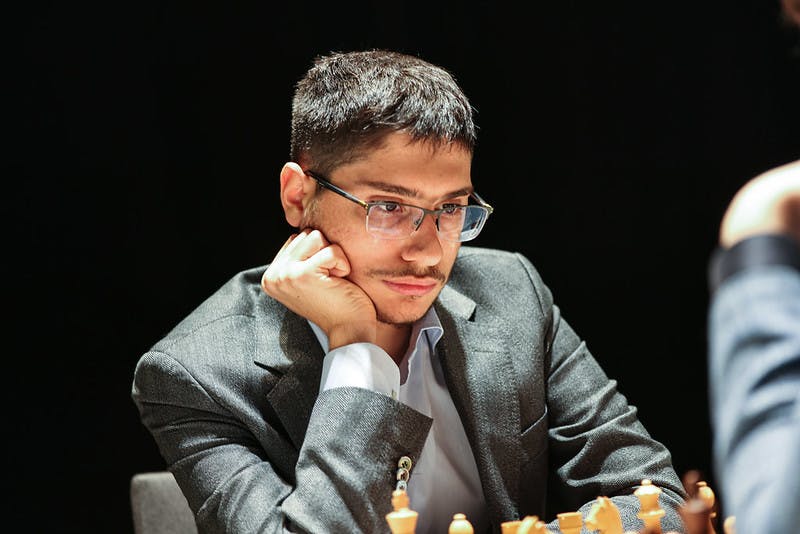Controversial Grand Swiss Underway in Riga: Rounds 1 - 6 Recap
The most prestigious Swiss event in the world is well underway - but at what cost?

The FIDE Chess.com Grand Swiss tournament was always going to have exciting games overlooked by the global pandemic - but it was unexpected by just how much. The action continues today and for the next five days with all games in the Open and Women's broadcast on Lichess from midday (12:00) UTC.
(all image credits - FIDE / Mark Livshitz / Anna Shtourman)
The Grand Swiss is the most prestigious Swiss tournament in the world, pitting over a hundred of the world’s top men and women chess players in a Swiss format (where those on the same number of points meet those on the same or similar number of points). At stake, two spots for the 2022 Candidates Tournament - the super-elite tournament which decides who will be the Challenger to the FIDE World Champion, and one spot for the 2022 Women’s Candidates Tournament.
Originally due to be played in Douglas - the capital of the Isle of Man - as it had been in 2019, complications due to the Covid-19 pandemic in the United Kingdom meant the organisers found an alternative venue in Riga, the capital of Latvia.
Controversy struck when just days before the tournament, Latvia had a sharp spike in Covid-19 cases, imposing strict restrictions on its residents and travellers - including a ban on non-essential travel and a curfew. FIDE applied for - and was granted - an exception for the tournament to continue as a major international sporting event, but several players chose not to risk attending the tournament.
In the Open, five of the top ten seeds withdrew - GMs Alexander Grischuk, Richard Rapport, Shakhriyar Mamedyarov, Hikaru Nakamura and Vidit Gujrathi. Other top grandmasters also withdrew - such as GMs Le Quang Liem, Salem Saleh, Bassem Amin, Gadir Guseinov, Arkadij Naiditsch, Etienne Bacrot, Maxime Lagarde, Sandro Mareco, Alexander Motylev, Ilya Smirin, Aravindh Chithambaram and Robert Hess. Additionally, in the Women’s section, GM Kateryna Lagno and IM Gunay Mammadzada, also withdrew.

https://twitter.com/viditchess/status/1451206837315911684?s=20
Stringent health procedures are in place with regular testing and a “bubble” environment within the official hotel and playing venue. However, the strength of the “bubble” environment is uncertain after some players and staff involved with the tournament visited local grocery stores, conducted some independent sightseeing (to Mikhail Tal’s grave), and have come into contact with people not within the bubble.
In any event, despite the self-isolation of the Chief Arbiter for several days for coming into contact with a Covid-positive individual (there is no suggestion the Chief Arbiter had Covid-19 at any point himself), the tournament goes on. And, despite the controversy - what magnificent chess it has produced so far. The tournament is all to play for in the Open section with seven players on 4.5 / 6, and another 13 players on 4 / 6 with another five rounds left to play. All the games can be found on Lichess for the Open here, and for the Women's here.
Meanwhile, in the Women’s section, GM Lei Tingjie is currently in the sole lead with 5 / 6, but closely pursued by four more players on 4.5 / 6, with another five rounds left to play.
If you want to try your hand at spotting game-winning tactics played in real games from the event, then try the puzzle-pack we've made from games played from this event so far:
https://lichess.org/study/peNyWsXQ
Otherwise, we’ve included some of our favourite games and recaps from the last few days in the Grand Swiss and Women’s Grand Swiss - unfortunately to include all of them would take up too much space. Let us know in the comments which one your favourite was - and which ones we should have included!
Round 1:
In the Women’s Grand Swiss, IM Sophie Milliet clashed with GM Alexandra Kosteniuk, in a game with a very intense middlegame and a near upset. With Kosteniuk opting for a Caro-Kann, Milliet nevertheless managed to get a comfortable position. Milliet continued opening up the centre, arriving to a critical moment in the game, and which could have been decisive there and then:
https://lichess.org/study/N0cmC6tJ/hFY3dkRc#33
Kosteniuk played the natural looking 17... Re8 - it protects the knight, moves the rook to an open file to fight for and you can activate your pieces and create some counter-play. Surprisingly, this natural looking move is actually a blunder after 18. Nc4!. Unfortunately for Milliet, she blundered back immediately, again with the natural looking 18. Bc2. The advantage continued to swing back and forth in a complex position, until both players equalised into a drawish looking game. In time trouble, Milliet came off worse in the endgame and after a critical blunder resigned.
Round 2:
In a gargantuan effort lasting over 7 hours and 142 moves, GM David Howell managed a jaw-dropping save in his game against GM Arturs Neiksans. Howell, after getting into an unpleasant position early in the game was practically forced to play 19. Nxe6 followed by 19... fxe6 20. Bd4 e5 21. Ba7, struggling to find good squares for his pieces. Things only got worse for him when, under time pressure, he missed a tactic and was forced to give up an exchange, ending up having to defend this position:
https://lichess.org/study/wMYxfWLu/1Gx13B6c#74
But Howell did not concede defeat and began a series of checks, whilst eliminating the threats of the g and h pawns. Neiksans had a chance to seize victory with 50... Qc4, where Howell would eventually run out of checks, but this was not played and Howell made a seemingly invincible fortress. The game continued, until it was drawn by the 50 move rule (50 moves without a capture or a pawn move).
An honourable mention in the Woman’s Grand Swiss has to go to GM Lei Tingjie’s stormy win over IM Ekaterina Atalik.
Round 3:
GM Daniil Dubov (with the black pieces) treated us (and himself) with a creative and aggressive masterclass against GM Vasif Durarbayli. Lasting just a bit over 30 moves, Dubov had already equalised out of the opening, and after 20... c6, black had a strong stable centre with no more chances for white to press or undermine in the near future. Dubov played 23... h4 with a very beautiful idea in mind:
https://lichess.org/study/GcPU1zgp/xFq63zWO#46
after 24. Bxh4, 24... Nxf4 is played forcing white to prevent Ne2+, and bringing in the queen to the attack with Qg4. In the game, 28. Kxf2 Rxf6+ 29. Kg1 Qe2 was played, and Durarbayli was soon forced to resign.

GM Daniil Dubov (image credit FIDE / Mark Livshitz)
Meanwhile, meteoric wunderkind GM Alireza Firouzja got his third win on the trot against GM Alexander Predke, taking him to an impressive sole lead of 3 / 3.
In the Women's Grand Swiss, the tournament opened up after WGM Natalia Pogonina drew GM Nana Dzagnidze who had been in the sole lead with 2 / 2. The young GM Zhansaya Abdumalik - who recently won the Women's Grand Prix in Gibraltar with 8.5 / 11 and a performance of 2699 - also scored a nice victory.

GM Zhansaya Abdumalik (image credit FIDE / Anna Shtourman)
Round 4:
Four-time Russian Women’s Champion, GM Valentina Gunina, faced two-time Chinese Women’s Champion, GM Lei Tingjie, with both players in the leading pack on 2.5 / 4. Gunina opted for a Caro-Kann, and with 3... Qc7 went into relatively uncharted ground - with no games in this position played in the Lichess Masters database by move 5. Even taking into account every rated game played on Lichess across all rating ranges, the position was entirely novel by move 9. Gunina initially seemed to have a lot of space on the queenside, but early on had an uncomfortable position and white was able to gain an advantage. A series of missteps from Gunina gave Tingjie a winning position by move 35, but the position over the board remained complex and abstract, full of isolated pawns, and pieces spread across all corners of the board. Tingjie was able to keep making sense of it, and was able to convert the endgame despite last attempts from Gunina to make it a draw.
https://lichess.org/study/ukYk5Lbg/alcwaO8C#70
Round 5:
With GM Alireza Firouzja’s change of federation, newfound compatriots Firouzja and GM Maxime Vachier-Lagrave clashed for not just French dominance, but also the spots for the 2022 Candidates Tournament. Opening with 1. e4, Vachier-Lagrave continued with the trademark Sicilian Najdorf for which he is well-known. Although Firouzja probed the position, Vachier-Lagrave never looked uncomfortable and was easily able to keep the position equal. After a drawish looking position was reached around move 30, the players agreed to a draw - a good outcome for Vachier-Lagrave with black, against a Firouzja who has looked ferocious this tournament (climbing to 5th place the in the live rating list, and with an unbelievable +7.6 rating gain overall).
https://lichess.org/study/6lQtt1t4/9tT8Q1Im#60
In the Women’s Grand Swiss, it was a decisive day with a flurry of wins putting five players into the joint lead on 4 / 5.
Round 6:
The joint leaders of the Open Grand Swiss, GM Alexei Shirov and GM Alireza Firouzja, met as the only players on 4 / 5 each. Shirov opened 1.e4 and Firouzja met it with 1... c6 - the Caro-Kann. Suitably for Riga the birthplace and hometown of the Soviet-Latvian 8th World Chess Champion, the players continued in the Tal variation (named after the eponymous GM Mikhail Tal) of the Caro-Kann. This was not just a shout-out to the legend it was named after; the Tal variation is an increasingly fashionable line being played at all levels. In the middlegame, it felt like Firouzja had the momentum and the engine favoured his position - but for a human brain the position and ways to convert it are complex and on a knife-edge.
With 35... Rxf2+ Firouzja would have had the option to trade both of his rooks for white’s queen and two pawns, with white keeping both of their rooks. But, two rooks versus a queen are technically slightly better - and Firouzja may have feared for a best case of forced threefold, and worst case of losing the queen entirely. Erring on the side of caution, Firouzja opted for the threefold - with one of the youngest players in the tournament, drawing against one of the oldest.

GM Alireza Firouzja (image credit FIDE / Mark Livshitz)
With their draw, five players in total are on 4.5 / 6 - GMs Alireza Firouzja, Alexei Shirov, Evgeniy Najer, Sasikiran Krishnan and Maxime Vachier-Lagrave.
In the upcoming round 7, Shirov will again face another generational test as the second-strongest junior in the world, GM Andrey Esipenko will be taking him on with white.
Meanwhile GM Baadur Jobava had the fewest-move win of the tournament so far - in just 14 moves against GM Jules Moussard. Moussard unfortunately blundered 11... Qh5, and after a few moves Jobava had put Moussard's queen in an uncomfortable spot. There are possibilities for Moussard, but even in the best case scenario Jobava would have ended a piece up in a winning position.
In the Women’s Grand Swiss, out of the leaders only GM Lei Tingjie secured a win - a methodical deconstruction of WGM Jolanta Zawadzka, showing the value of well-protected and advancing central pawns. The win pushed Tingjie into sole first place in the Women’s Grand Swiss.